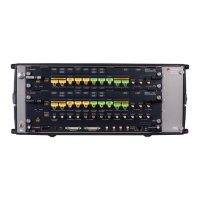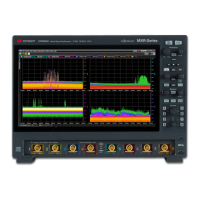Do you have a question about the Keysight MSOX3024T and is the answer not in the manual?
| Bandwidth | 200 MHz |
|---|---|
| Sample Rate | 2 GSa/s |
| Vertical Resolution | 8 bits |
| Memory Depth | 4 Mpts |
| Waveform Update Rate | 1, 000, 000 wfms/s |
| Connectivity | USB, LAN, GPIB (optional) |
| Input Impedance | 1 MΩ |
| Maximum Input Voltage | 300 Vrms |
| Trigger Types | Edge |
| Operating Temperature | 0 °C to 50 °C |
| Channels | 4 analog + 16 digital |
Power requirements and procedure for turning on the oscilloscope.
Steps for connecting oscilloscope probes to the input BNC connectors.
Automatically configures settings for optimal display of input signals.
Match probe compensation to channel for accurate measurements.
Identification and function of front panel keys, knobs, and connectors.
Guide to using touch gestures for oscilloscope control and navigation.
Access the oscilloscope's built-in help system.
Adjusting the time base setting using the horizontal scale knob.
Adjusting the horizontal position of the trigger point using the delay knob.
Using horizontal knobs to pan and zoom waveforms after acquisition.
Using the search key to find specific events like edge, pulse width, or serial data.
Enable or disable channel or math waveforms display.
Setting the vertical sensitivity (volts/division) for a channel.
Moving the waveform display up or down on the screen.
Selecting input coupling between AC or DC for a channel.
Setting the analog channel input impedance to 50 Ohm or 1 MOhm.
Selecting probe parameters like attenuation factor and measurement units.
How to search for frequency peaks in the FFT math function waveform.
Awareness of frequency aliasing in FFT and how to mitigate it.
Steps to display math waveforms by selecting operators, transforms, and sources.
Saving analog channel or math waveforms to reference locations for comparison.
Saving and recalling reference waveforms to/from USB storage.
Connecting digital probes to the device under test, ensuring proper power supply.
How the oscilloscope acquires and stores digital channel data based on voltage thresholds.
Using Autoscale to quickly configure and display digital channels.
Setting the logic threshold voltage for digital channels.
Overview of available hardware-accelerated serial decode options and licenses.
Using the Lister tool to view large amounts of packet-level serial data in a tabular format.
Using the search capability to find and mark specific data in the serial Lister.
Adjusting waveform intensity to better view signal details, especially in complex signals.
Configuring display persistence (off, infinite, or variable) to track waveform updates.
Setting the voltage level for analog channel edge detection using the Trigger Level knob.
Forcing a trigger to acquire and display data when triggers are not occurring.
Setting up triggers based on specified edge slope and voltage level on a waveform.
Triggering when the Nth edge occurs after an arming edge and a delay period.
Triggering on positive or negative pulses of a specified width or timeout value.
Identifying trigger conditions based on specified patterns across channels and edges.
Triggering on specific lines, sync pulses, or fields of standard video signals.
Triggering on specific serial bus protocols like CAN, LIN, I2C, SPI, etc.
Selecting between Auto (default) or Normal trigger modes for acquisition behavior.
Using front panel keys [Run/Stop] and [Single] to start, stop, and capture single acquisitions.
Choosing acquisition modes like Normal, Peak Detect, Averaging, or High Resolution.
Using horizontal and vertical cursors to measure custom voltage, time, phase, or ratio.
Using the [Meas] key to display the Measurement Menu and add automatic measurements.
Understanding voltage measurement points like peak-peak, maximum, minimum, amplitude, top, and base.
Measuring rise time, fall time, delay, phase, period, frequency, and pulse parameters.
Configuring the oscilloscope to display a golden waveform for creating a mask.
Using the DVM feature for 3-digit voltage measurements on analog channels.
Using the counter feature for frequency, period, or edge event measurements.
Configuring sweep frequencies, channels, and amplitude for FRA analysis.
Accessing Waveform Generator Menu to select and enable waveform types.
Saving setups, screen images (BMP/PNG), and acquired data (CSV, ASCII XY, BIN).
Configuring remote access via USB device port or LAN interface.
Establishing a LAN connection for network printing, web interface, or remote control.
Connecting to the oscilloscope via LAN and accessing its web server using a Java-enabled browser.
Connecting to CAN signals and specifying source, threshold, baud rate, and sample point.
Setting up triggers for CAN version 2.0A, 2.0B, and CAN FD signals based on various conditions.
Setting up serial decode for CAN and CAN FD signals, including interpretation of display.
Connecting to FlexRay signals and specifying source, threshold, baud rate, and bus type.
Connecting to I2C signals and specifying source, threshold, and address.
Triggering on I2C signals based on start/stop conditions, restart, missing acknowledge, or EEPROM data.
Connecting to SPI signals and specifying clock, MOSI, MISO, and framing signal parameters.
Connecting to I2S signals and specifying clock, word select, and data line parameters.
Connecting to Manchester signals and specifying signal, bus configuration, and settings.
Connecting to NRZ signals and specifying signal, bus configuration, and settings.
Connecting to MIL-STD-1553 signals and specifying source and trigger threshold levels.
Connecting to ARINC 429 signals and specifying source, threshold, speed, and signal type.
Connecting to SENT signals and specifying source, threshold, bus configuration, and message format.
Connecting to UART/RS232 signals and specifying source, threshold, baud rate, and parity.











